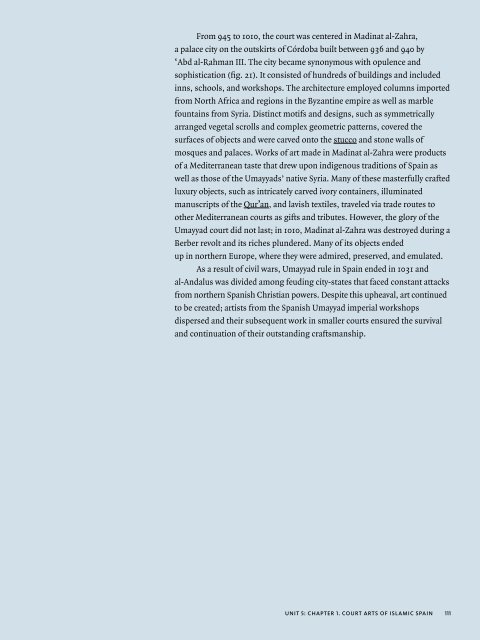Courtly Splendor in the Islamic World - The Metropolitan Museum of ...
Courtly Splendor in the Islamic World - The Metropolitan Museum of ...
Courtly Splendor in the Islamic World - The Metropolitan Museum of ...
Create successful ePaper yourself
Turn your PDF publications into a flip-book with our unique Google optimized e-Paper software.
From 945 to 1010, <strong>the</strong> court was centered <strong>in</strong> Mad<strong>in</strong>at al-Zahra,<br />
a palace city on <strong>the</strong> outskirts <strong>of</strong> Córdoba built between 936 and 940 by<br />
‘Abd al-Rahman III. <strong>The</strong> city became synonymous with opulence and<br />
sophistication (fig. 21). It consisted <strong>of</strong> hundreds <strong>of</strong> build<strong>in</strong>gs and <strong>in</strong>cluded<br />
<strong>in</strong>ns, schools, and workshops. <strong>The</strong> architecture employed columns imported<br />
from North Africa and regions <strong>in</strong> <strong>the</strong> Byzant<strong>in</strong>e empire as well as marble<br />
founta<strong>in</strong>s from Syria. Dist<strong>in</strong>ct motifs and designs, such as symmetrically<br />
arranged vegetal scrolls and complex geometric patterns, covered <strong>the</strong><br />
surfaces <strong>of</strong> objects and were carved onto <strong>the</strong> stucco and stone walls <strong>of</strong><br />
mosques and palaces. Works <strong>of</strong> art made <strong>in</strong> Mad<strong>in</strong>at al-Zahra were products<br />
<strong>of</strong> a Mediterranean taste that drew upon <strong>in</strong>digenous traditions <strong>of</strong> Spa<strong>in</strong> as<br />
well as those <strong>of</strong> <strong>the</strong> Umayyads’ native Syria. Many <strong>of</strong> <strong>the</strong>se masterfully crafted<br />
luxury objects, such as <strong>in</strong>tricately carved ivory conta<strong>in</strong>ers, illum<strong>in</strong>ated<br />
manuscripts <strong>of</strong> <strong>the</strong> Qur’an, and lavish textiles, traveled via trade routes to<br />
o<strong>the</strong>r Mediterranean courts as gifts and tributes. However, <strong>the</strong> glory <strong>of</strong> <strong>the</strong><br />
Umayyad court did not last; <strong>in</strong> 1010, Mad<strong>in</strong>at al-Zahra was destroyed dur<strong>in</strong>g a<br />
Berber revolt and its riches plundered. Many <strong>of</strong> its objects ended<br />
up <strong>in</strong> nor<strong>the</strong>rn Europe, where <strong>the</strong>y were admired, preserved, and emulated.<br />
As a result <strong>of</strong> civil wars, Umayyad rule <strong>in</strong> Spa<strong>in</strong> ended <strong>in</strong> 1031 and<br />
al-Andalus was divided among feud<strong>in</strong>g city-states that faced constant attacks<br />
from nor<strong>the</strong>rn Spanish Christian powers. Despite this upheaval, art cont<strong>in</strong>ued<br />
to be created; artists from <strong>the</strong> Spanish Umayyad imperial workshops<br />
dispersed and <strong>the</strong>ir subsequent work <strong>in</strong> smaller courts ensured <strong>the</strong> survival<br />
and cont<strong>in</strong>uation <strong>of</strong> <strong>the</strong>ir outstand<strong>in</strong>g craftsmanship.<br />
unit 5: chapter 1. court arts <strong>of</strong> islamic spa<strong>in</strong><br />
111

















